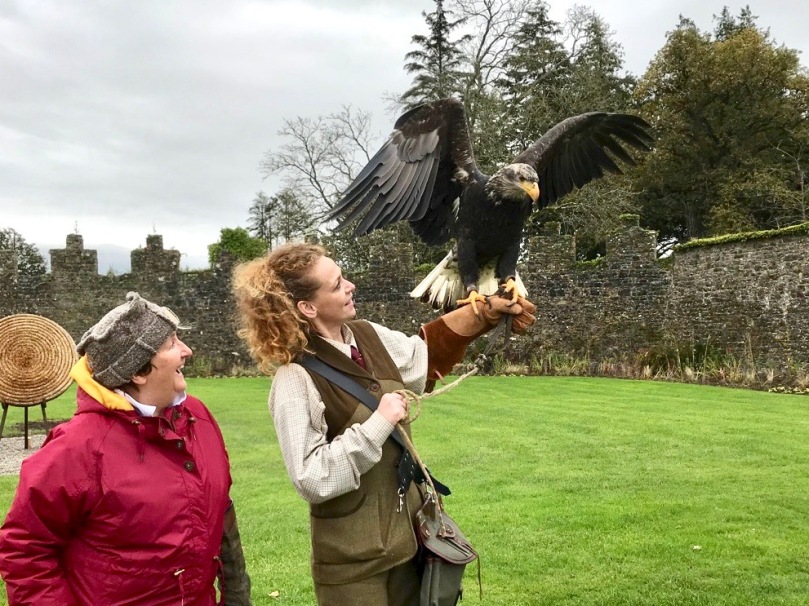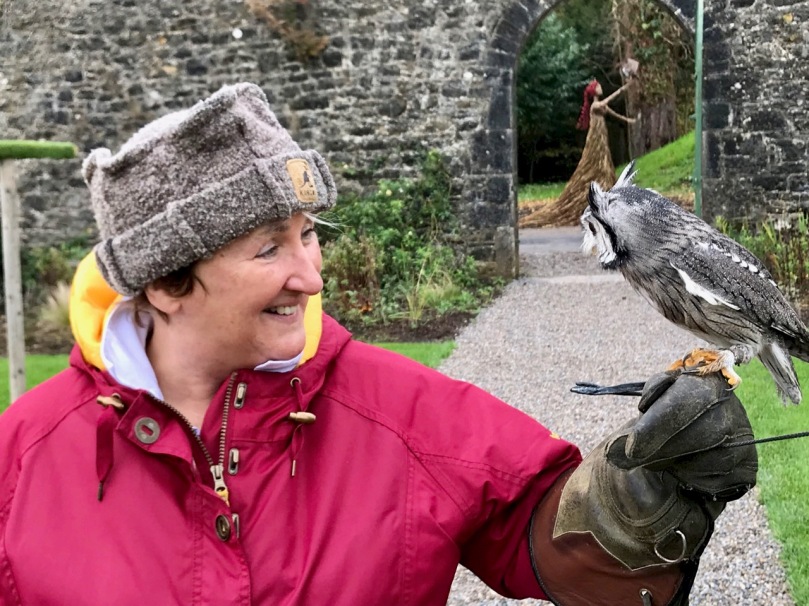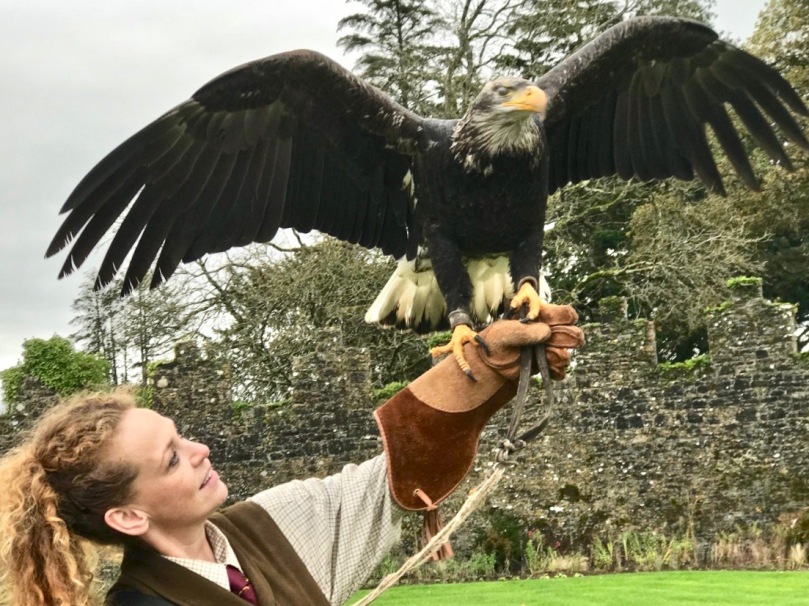I’ve waited a whole life for this – the chance to be a falconer, if only for a moment.
Ever since I read T H White’s The Once and Future King, it’s been a fantasy of mine to interact with one of those magnificent hunting birds that he described so well. A couple of weeks ago, at Adare Manor, Robert and I got a chance to finally live that dream – yes, he read the same book and loved it just as much as I had. T H White was a falconer himself, although not a very successful one. The treat was part of a couple of days stay at Adare Manor – Robert’s post describes this fascinating place in wonderful detail.
This falcon is happier and calmer with his hood on
Our falconer at Adare Manor was Susan Kirwan, one of the team at Adare Country Pursuits. What she doesn’t know about birds would fit on a postcard. She trained her first bird, a jackdaw, at the age of nine, and was hooked. Now she shares her knowledge and her love of birds with those of us who have admired from afar but have never had an opportunity to get up close.
Susan has Saoirse, the American Bald Eagle, show off her wings
She spent the morning with us, handling each bird in turn and giving us an education on each one – habitat, habits, hunting style, personality, peculiarities, nutrition, feathers, weight – it was in-depth and fascinating. There wasn’t a question we asked that she couldn’t answer. She has spent her life studying and living with these birds.
All of the birds wore jesses (ankle leathers) and Susan showed us how to hold our gauntlets and our fingers to secure a bird once on the glove. She encouraged us to speak in a calm voice and not to betray nervousness – birds are excellent at picking up on human emotions.
Tiny, the White Faced Scopes Owl, awaits her turn with us
Some of the birds were trained to fly from perch to perch, attached to a ‘creance’ or long line. Each has a optimal weight for flying and it’s essential to keep it there, so weighing and inspecting is part of the daily routine. Food must be as close as possible to what they would eat in the wild, to preserve the level of roughage and protein. Falconry, especially when you keep several birds, is a full-time job.
Caesar is a Common Buzzard, which is a native species in Ireland
Owls, although excellent hunters for themselves, don’t make the greatest falconry hunters. However, they are often brought to Susan as motherless chicks and she becomes their parent, as they imprint readily on a human. Susan told us that the Harry Potter series started a trend among some young people of capturing owls ‘to train’ but of course this is almost impossible for an amateur, so that is how some birds have come to her aviary.
Noddy, a Dark Breasted Barn Own, has beautiful feathers and colouring

Oscar, a Eurasian Eagle Owl, has a good old ruffle
Raising an imprinted bird involves a particular set of skills and deep knowledge of the species. Susan is a certified falconer and has taken all the courses she can find to develop her skills. It was obvious, in the way she talked to and handled her birds how much she loved them.
Top: I’m obviously a ‘natural’ at this! Bottom: Well, maybe not quite yet
It was a thrill to be so close to a bald eagle. Living in Canada, I had many opportunities to observe these magnificent creatures in the wild, but I had never seen one as close up as I did at Adare. Saoirse is not quite four yet, and it takes a full four years for a bald eagle to mature and to grow both the white head and the white tail. Saoirse’s tail was there, but her head was at the salt-and-pepper stage that women of my age can relate to.
The Harris Hawk – ours was called Felix – is considered the easiest hunting bird to train because of its laid-back attitude to life and its natural ability to interact with humans. The highlight of our session came when Susan let Felix loose to fly to a high perch, and then called him down to land on our glove.
What a feeling! This IS a wild bird – Susan affixed a locator transmitter to its leg before we started so that if Felix took it into his head to fly away she could track him through the woods. She described how a falconer would track a bird before locators were used – it involved standing very still and tuning in to the sounds of the forest. Other birds would react to the sudden appearance of a hawk or falcon and the falconer would follow the sound-clues to his bird.
I learned that Oscar’s tufts aren’t his ears and that they don’t always stand up like this
We were extremely lucky to have Susan and her birds all to ourselves that morning – not sure how often that happens! But if you get a chance, don’t pass up an opportunity like this. It’s a once-in-a-lifetime experience. Thank you, Susan – you’ve made some old T H White fans very happy!














Quite an experience. It must be awesome to spend some time with someone like Susan. Finola you might like to read fellow blogger Janna Noelle’s post on falconry in the Middle Ages http://bit.ly/2Bcxqm1
LikeLike
Thanks for that link, Roy – very interesting post!
LikeLiked by 1 person
I recommend H is for Hawk by Helen MacDonald.
LikeLike
Seems to be a popular one!
LikeLike
I recommend H is for Hawk, by Helen MacDonald. I too love The Goshawk.
>
LikeLike
That must have been a lot of fun. What a great opportunity.
LikeLiked by 1 person
Such beautiful creatures! (I include you amongst them, in that wonderful chapeau…) I am inexpressibly envious! I loved T. H. White’s “The Goshawk” (as well as Helen Macdonald’s more recent “H is for Hawk”, a tribute of sorts to THW’s book). Wonderful photographs, too (Robert’s work?)
LikeLike
Yes, mostly Robert’s photos. Robert has read The Goshawk but I haven’t. Thanks for the comments / it was a real thrill.
LikeLike